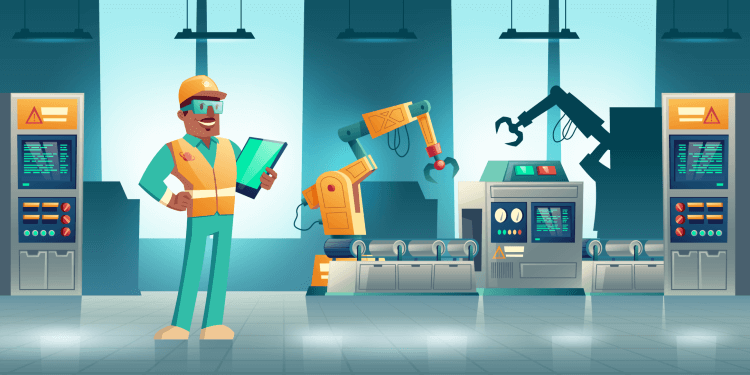
What Is Manufacturing-as-a-Service and Why Is It Important?
April 28, 2023 - Emily Newton
Revolutionized is reader-supported. When you buy through links on our site, we may earn an affiliate commission. Learn more here.
The future of manufacturing — and probably every other industry — is looking more communal and collaborative by the day. Nothing demonstrates this better than the rise of manufacturing-as-a-service (MaaS). Everybody knows that it takes just one good idea to change the world. Yet, not everyone has the capital to get their idea off the ground all by themselves.
That’s where MaaS enters the picture. It’s a way to distribute and share the functions that are most critical in manufacturing today. Doing so eases the investment burden for smaller companies. It also helps us use resources more effectively and lowers the barrier of entry for companies that want to capitalize on new technologies. Let’s take a closer look.
What Is Manufacturing-as-a-Service?
MaaS is one of the chief opportunities unlocked by widescale business digitization. Look around you at the competitive global economy and the urgent calls-to-action to use Earth’s resources less wastefully. With challenges like these, using emerging technologies and connected services to make manufacturing more efficient, and businesses leaner, isn’t optional. It’s mandatory.
Manufacturing-as-a-service offers a way for companies to remain committed to their core mission. They can focus on product innovation while outsourcing the actual process, along with critical services and technologies, to an outside party.
The modern factory contains a host of emerging technologies. It features things like:
- Sensors, edge computing and IoT systems for industrial equipment
- Big data analytics for enterprise resource planning (ERP)
- Cloud storage, connectivity and collaboration tools
If you want to open a grocery store, you might not have the cash on hand to open the refrigerated warehouses or even purchase the building you’ll occupy. Therefore, you lease the property and pay over time for continuous access to the assets your company needs to remain operational.
MaaS is similar. The company doing the outsourcing owns the intellectual property. They’re the ones innovating on their products over time. With MaaS, they don’t have to purchase and upgrade the ever-more-complex physical and digital manufacturing apparatus they need to get their products into users’ hands.
The chief benefit of MaaS for companies is that they get to consolidate their ongoing costs into an easier-to-manage single contract. It means lower overhead and improved profitability. However, cost savings are just one way to look at the opportunities MaaS represents.
How Is MaaS Revolutionizing Manufacturing?
You might think of MaaS as “cloud networked manufacturing.” The service provider may not be located anywhere near its clients’ facilities, yet it provides infrastructure for several companies at once.
You’ve heard of the sharing economy — usually in reference to platforms like Uber or Fiverr — but MaaS is its large-scale industrial counterpart. Here’s how it’s revolutionizing manufacturing:
1. Controlling Costs and Lowering Overhead
Manufacturers need lots of standard and specialized equipment to get batches of products out the door. Some of the most common industrial equipment categories include:
- Industrial power systems and generators
- Centrifuges and mixing equipment
- Boilers and chillers
- Conveyors, robots and material-handling equipment
- Sorting and packaging equipment
This is a serious amount of overhead for an entrepreneur or small company that’s trying to seize the moment and get their product made. MaaS allows them to use a third party’s infrastructure to turn their concept into a reality. Doing this saves them considerable investment expenses, as well as the cost of labor, maintenance and upgrades.
2. Providing Access to New Technologies
A related issue for manufacturers involves the accelerated pace of technological innovation. Many companies prefer renting or leasing critical equipment because making a purchase outright might mean it’s out-of-date in a few short years.
The Internet of Things has introduced lots of innovations, some of which we’ve touched upon. Integrated equipment analytics, internet connectivity, automation and machine learning are all entwined with modern manufacturing. This raises the barrier of entry higher and makes equipment investments a more difficult pill to swallow for smaller companies.
Using manufacturing-as-a-service unlocks access to emerging technologies and their benefits for the client company. The MaaS provider pays for the equipment and plans for its eventual retirement and replacement. In the meantime, the client company reaps the benefits of the technology without fretting about oftentimes-harsh upgrade cycles.
3. Boosting Innovation, Customization and Time-to-Market
Additive manufacturing, known as 3D printing, could become the keystone in manufacturing-as-a-service.
Multiple companies are demonstrating how 3D printing could become the most shareable manufacturing asset to date. One example, Techniplas Digital, has made itself the “Airbnb of auto e-manufacturing” by offering remote 3D printing services to companies that need automotive parts and other critical machined products.
This business model is distributed in nature and efficient. Techniplas is an online platform that connects clients with manufacturers that have unutilized 3D printing capacity and geographical proximity to the client. The result capitalizes on the benefits of 3D printers. They provide faster prototyping, quicker time-to-market and the ability to personalize short runs of products. It combines innovation with the power of the sharing economy.
What Challenges Does Manufacturing-as-a-Service Solve?
Succeeding as a modern manufacturer isn’t easy. Fortunately, the MaaS business model unlocks opportunities for manufacturers to thrive instead of struggle, even while facing industry and marketplace obstacles. Here are some of the common issues that manufacturing-as-a-service can overcome for the people that use it.
1. Troubles Tied to the Manufacturing Labor Shortage
Research published in 2021 indicated there could be more than 2.1 million unfilled manufacturing jobs in the United States by 2030. Another takeaway was that respondents said it was 36% harder to fill jobs at the time of the study compared to 2018. Some executives revealed they cannot even find candidates for the entry-level positions, let alone the more specialized roles.
The tricky reality of this situation is that there’s no single cause or solution. Part of the problem is that some manufacturing professionals took time to assess their job satisfaction and decided to get reskilled when the COVID-19 pandemic caused many layoffs and short-term closures.
Additionally, some younger people — including those about to choose their college courses — perceive manufacturing as dirty and dangerous work. It can be, but the chances are less likely when companies take the right measures to create safe working conditions where everyone understands the rules and gets proper training. A related problem is that people from younger generations may prefer more tech-centered roles, not realizing manufacturing is becoming more technologically oriented.
Moreover, training recruits takes more time than executives might expect. Retirement is a major contributor to the manufacturing labor shortage. That’s why some companies in the sector have tried a semi-retirement approach and asked formerly retired workers to come back and work fewer hours than they did before. Doing that enables the necessary knowledge transfer between newer workers and those who have become extremely familiar with their roles over the years.
Manufacturing-as-a-service cannot solve all labor problems. However, the business model is a valuable supplement for executives who may spend weeks or months trying to hire new workers for on-site jobs. If a company decision-maker finds a MaaS provider, that company can handle work left by skills shortages.
2. Manufacturers Spending Less Time on Core Competencies
Core competencies are the distinctive attributes that allow companies to stand out from their competitors. Developing and harnessing those characteristics is essential for conquering a perpetually challenging marketplace.
However, when manufacturers lack the required resources, they often waste time and money doing things better left to others who are better-equipped for the duties. When manufacturers have less time to focus on core competencies, goals become harder to achieve, and a company may have a less well-defined purpose.
Fortunately, the MaaS model is purpose-built for manufacturers who are ready to leave some responsibilities to outside companies. Specific manufacturing-as-a-service examples can highlight why that’s the case.
Consider 3D Print Western, which specializes in rapid prototyping using additive manufacturing. Perhaps a company leader is extremely interested in pursuing 3D printing but is not quite ready to take the leap by purchasing the necessary equipment. This alternative allows them to explore the manufacturing method without getting distracted from the other parts of their business.
There’s also Argonaut, a startup focusing on MaaS in medicine. Since the pharmaceutical industry has such tight and particular regulations, many manufacturers who are relatively new to the field may wish to work with people who already know the stipulations well and won’t make costly or dangerous mistakes.
Openness to new options is an integral part of success, regardless of the kinds of products produced. However, learning more about what’s available can also become a time sink, especially when people think the only possibility is to get set up to use the technology themselves. Manufacturing-as-a-service offers an appealing alternative that enables producers to keep devoting the most time to what they do best.
The Case for Manufacturing-as-a-Service
Companies with in-house infrastructure are under constant pressure to maximize their manufacturing capacity utilization and eliminate downtime. A production line that isn’t running is bad for business — and it represents a misplaced investment.
As Deloitte noted in May 2018, the United States has had a difficult relationship between manufacturing capacity and output for the past several decades. Companies’ average manufacturing capacity utilization ebbs and flows over time, but there has been a definitive downward decline since at least 1970.
Productivity-boosting technologies are a main culprit for this downward trend. Technology helps us do more work with fewer investments in physical infrastructure. The decline in manufacturing capacity utilization means the world has a greater surplus of facilities and equipment over time. Companies that invest in their own infrastructure will see those assets sitting unused more than they’d like. This is a waste of time, capital and energy.
The case for MaaS practically makes itself when you consider how reliably manufacturing productivity has increased and how steadily capacity utilization has fallen.
The Internet of Things has brought industry to new levels of productivity. Meanwhile, the sharing economy creates a new business model. Those with capacity to spare can share it, for a price, with those in need. Everybody’s bottom line benefits, and the planet has fewer factories operational that aren’t producing goods.
Featured Image Credit: Technology vector created by vectorpocket via Freepik
Editor’s note: This article was originally published on May 14, 2020 and was updated April 28, 2023 to provide readers with more updated information.
Revolutionized is reader-supported. When you buy through links on our site, we may earn an affiliate commission. Learn more here.
Author
Emily Newton
Emily Newton is a technology and industrial journalist and the Editor in Chief of Revolutionized. She manages the sites publishing schedule, SEO optimization and content strategy. Emily enjoys writing and researching articles about how technology is changing every industry. When she isn't working, Emily enjoys playing video games or curling up with a good book.






